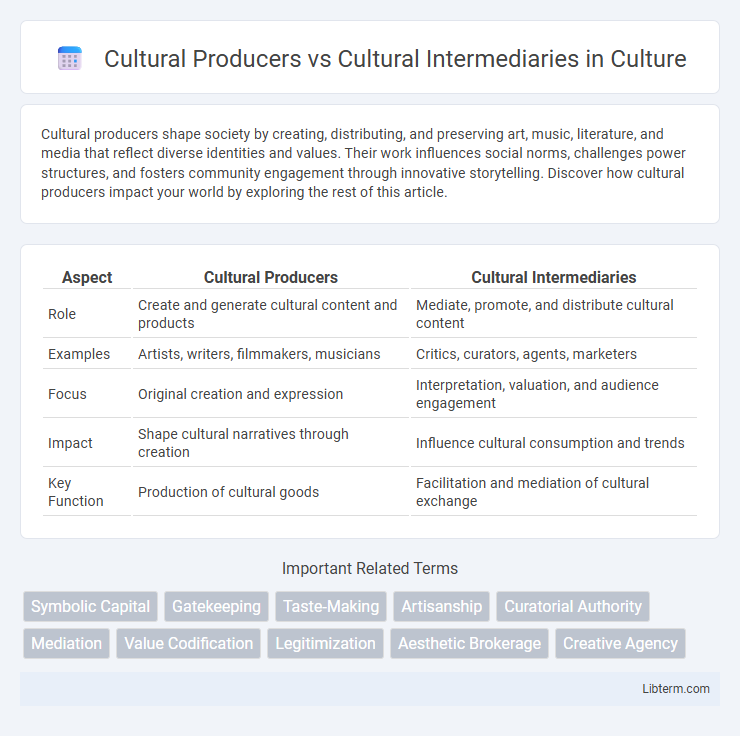Cultural producers shape society by creating, distributing, and preserving art, music, literature, and media that reflect diverse identities and values. Their work influences social norms, challenges power structures, and fosters community engagement through innovative storytelling. Discover how cultural producers impact your world by exploring the rest of this article.
Table of Comparison
| Aspect | Cultural Producers | Cultural Intermediaries |
|---|---|---|
| Role | Create and generate cultural content and products | Mediate, promote, and distribute cultural content |
| Examples | Artists, writers, filmmakers, musicians | Critics, curators, agents, marketers |
| Focus | Original creation and expression | Interpretation, valuation, and audience engagement |
| Impact | Shape cultural narratives through creation | Influence cultural consumption and trends |
| Key Function | Production of cultural goods | Facilitation and mediation of cultural exchange |
Defining Cultural Producers and Intermediaries
Cultural producers are individuals or organizations engaged in the creation and direct production of cultural goods, such as artists, musicians, writers, and filmmakers, who generate original content. Cultural intermediaries, by contrast, function as mediators who influence the consumption and distribution of cultural products, including critics, curators, marketers, and media professionals who shape audience reception and cultural value. These roles highlight the distinction between creators of culture and agents who facilitate the cultural experience through promotion, interpretation, and mediation.
Historical Evolution of Cultural Roles
Cultural producers, historically rooted in direct creation and artistic craftsmanship, have evolved alongside cultural intermediaries who mediate, distribute, and market cultural products to broader audiences. The shift from artisan-centric societies to mass media and digital platforms expanded the role of intermediaries, who now shape cultural consumption and trends. This evolution reflects changing economic and technological contexts, highlighting a dynamic interplay between creation and mediation in cultural ecosystems.
Key Differences Between Producers and Intermediaries
Cultural producers create original content such as art, music, literature, and film, directly influencing cultural expression and innovation. Cultural intermediaries serve as mediators, promoting, distributing, and interpreting cultural products to audiences, often shaping market trends and consumer perceptions. The primary difference lies in creators generating content, while intermediaries facilitate its access and reception within the cultural ecosystem.
Influence on Cultural Content Creation
Cultural producers directly shape cultural content by generating original works such as art, music, literature, and film, embedding their creative vision and socio-cultural influences into the final product. Cultural intermediaries influence cultural content indirectly by curating, promoting, and distributing these creations, thereby affecting audience perception and market success. Their role determines which cultural products gain visibility and acceptance, ultimately guiding cultural trends and consumer behavior.
Mediation and Gatekeeping Functions
Cultural producers create original content that shapes cultural expressions, while cultural intermediaries mediate and filter this content before it reaches audiences, acting as gatekeepers in the distribution process. Intermediaries influence cultural value by selecting, promoting, and contextualizing works, thus guiding consumer reception and market trends. Their gatekeeping functions determine which cultural products gain visibility, affecting both cultural consumption patterns and the economic success of producers.
Power Dynamics in Cultural Industries
Cultural producers, such as artists and creators, generate original content while cultural intermediaries, including critics, curators, and marketers, shape the perception and distribution of this cultural output. Power dynamics in cultural industries often favor intermediaries who control access to markets, funding, and audience attention, influencing which cultural products gain visibility and legitimacy. This gatekeeping role can create asymmetrical relationships where producers depend on intermediaries to navigate institutional structures and achieve commercial or critical success.
Case Studies: Music, Art, and Media
Case studies in music, art, and media reveal that cultural producers, such as artists, musicians, and filmmakers, create original content that embodies cultural expression and innovation. Cultural intermediaries, including critics, curators, and media promoters, shape the public's reception and interpretation of these works through marketing, curation, and discourse framing. This dynamic influences cultural value, access, and the commodification process within creative industries.
Impact on Cultural Consumption Patterns
Cultural producers create original content such as films, music, and literature, shaping cultural consumption by introducing new ideas and aesthetics that influence audience preferences. Cultural intermediaries, including critics, curators, and marketers, mediate between producers and consumers, guiding taste formation and access to cultural products through interpretation and promotion. The dynamic interaction between producers and intermediaries significantly affects cultural consumption patterns by determining which cultural products gain visibility and how they are framed for diverse audiences.
Challenges in Distinguishing Roles
Distinguishing between cultural producers and cultural intermediaries presents challenges due to overlapping roles in content creation, distribution, and mediation processes. Cultural producers generate original artistic or cultural content, while intermediaries facilitate access, interpretation, and promotion of such content, often blurring boundaries. The evolving digital landscape further complicates role clarity, as platforms enable producers to assume intermediary functions, intensifying the need for precise role definition in cultural industries.
Future Trends in Cultural Production and Mediation
The future of cultural production emphasizes immersive technologies such as augmented reality and AI-driven content creation, enabling Cultural Producers to craft more personalized and dynamic experiences. Cultural Intermediaries are increasingly leveraging data analytics and blockchain to authenticate, distribute, and monetize cultural goods transparently, reshaping value chains and audience engagement. Collaborative ecosystems integrating digital platforms and hybrid physical-digital events will redefine the roles and interactions between Cultural Producers and Intermediaries.
Cultural Producers Infographic

 libterm.com
libterm.com